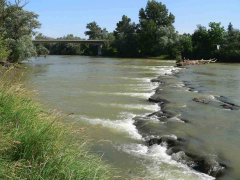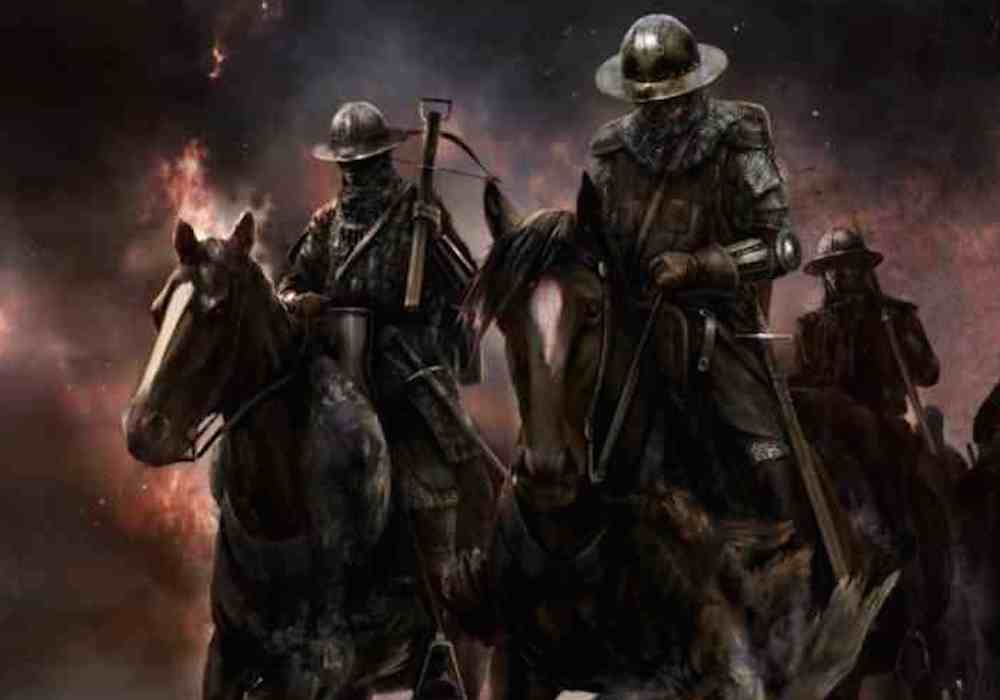
Character Arc
Price Edward has been raised as heir to the English throne. The emphasis in his education has been on duty and courage, on honour and chivalry. At the age of 25 he is perceived to have excelled in all these areas.
He is told by his father that he must marry Ximene Trencavel, the heiress to Occitan. King Edward has always wanted the Prince to make a politically advantageous marriage. He has now become totally committed to a marriage between the Prince and Ximene. Worse still the Pope supports this union as it will create a third european state of the same size and strength as the Holy Roman Empire and the Frankish empire. this has the potential to free the Pope from temporal control by the other two. The Prince is aware that there is an inescapable finality about the vows of marriage and the procreation of children. To do his duty he must marry Ximene. This raises conflicts of honour. If he marries Ximene it will hurt the one he loves, Joan of Kent. If he then claims Occitan for England it will break an understanding he has with the French King. On the other hand if he does not claim Occitan then his new wife, his father and the Pope will all believe he has failed in his duty.
Joan figures prominently in his troubled conscience as he believes she has been badly treated by his family and that even now he is using her. He cannot resist her, he takes every possible opportunity to be with her and yet he knows that she wants to be the next Queen of England, something he cannot promise her.
The conflicting demands are removed, partly by circumstantial events, partly by Joan’s tireless efforts, but also by the generosity of spirit of a remarkable young woman, Ximene Trencavel.
He still allows his perception of honour and duty to dominate his life but he now begins to give greater priority to his personal relationships. He commits himself to marry Joan, his childhood sweetheart, and to find a way of doing it without compromising honour or duty
Details of Edward’s Journey
In 1355 his father determined to appoint Edward “Prince of Aquitaine” This is in fact a calculated insult to the French King as in French eyes the English are rebels who still owe fealty to France for Aquitaine and the surrounding territories. In French eyes the highest title the Prince could be awarded would be “Duc D’Aquitaine”.
His Father King Edward III of England has, as son of the only surviving member of the Capet dynasty, a significantly better claim to the French throne than the distant Valois cousin appointed King by the French Nobles. French law has been altered to disbar King Edward from the French throne. Nevertheless he still sees himself as the King of France, he sees King John as a usurper and the noblemen who support John as rebels. He will never give up his claim. The Prince’s duty is therefore to wage war on the usurper.
In the Prince’s eyes this is all unrealistic. In 1344 his father had reneged on his loans to the Italian banks causing a financial crisis in Europe. The King cannot now borrow money to support the cost of his internal administration or his wars with France and Scotland. Several big landowners have lent him money, but they have now been bled dry. In Aquitaine high taxation is encouraging the lords to shift their allegiance to the French king. The latest example is the Compte d”Armagnac. England is struggling to put together an army to remind Armagnac where his true allegiance should lie. There is a desperate need for either addition funds or peace.
The Prince himself would be happy to swear allegiance to the French King and end the conflict, but only on terms which would return to him all the lands to which he can claim to be heir, which would include Normandy, Anjou, Saintes, the Agenaise and Armagnac.
Friendship with Salisbury
His close friend since childhood, William Montacute, the Earl of Salisbury who is commander of the Prince’s Rearguard, a term which includes intelligence and espionage, is in constant contact with the French, preparing the ground for the implementation of the new situation which will only be possible after the death of the Princes’s father, also called Edward (III of England).
In the meantime the Prince wages war in as honourable manner as possible. To inflict defeats on the French can do nothing but help his eventual negotiating position
Salisbury advises him that the Pope is relatively happy with the religious situation in England . The Pope knows that a number of the leading families and the royal family itself have Cathar sympathies. However he appreciates the way these views are never publically promoted and that there are no Cathar ceremonies outside the privacy of private homes. The Pope believes that if the Prince assumed control of Occitan, he would suppress any move towards the re-establishment of the Cathar faith but impose similar constraints to those in place in England.
Salisbury however brings back a message from the French that a marriage with Ximene would be unnacceptable. There would then be a Duc who controlled more territory than the French king himself!
In our story
In 1355 Occitan was in a ferment of rebellion. If Ximene had been prepared to swear allegiance to the King of the Franks and marry his son Louis of Anjou she could well have regained the family lands, possibly in her own right. She believed however that this could only been possible if she had renounced her Cathar faith, something she was never prepared to do. She was not only a commited to the faith but also to creating to creating a haven where the faith could be practiced without persecution.
Under the influence of her Grandmother she came to believe that the only way this could be achieved is by forming an alliance with the Plantagent rulers of England and Aquitaine. Aquitaine is one of the “Four Quarters” of Occitan, speaking the same language and sharing the same culture. The most obvious way to make such an alliance would be to marry into the Plantagenet family. The heir to the Plantagenet throne is Edward of Woodstock, the Black Prince. Ximene is told he is available and wishes to meet her. There is exited talk that it might be possible with the Prince’s support to unite all of Occitan into a new nation with its own language its own natural borders and its own culture.
The Sangreal
During the negotiations about the proposed marriage, Ximene discovers that one of the factors which has made her attractive to the Prince is that she has inherited the Sangreal, the Holy Blood. Those who carry this blood are considered to have the right to rule and every Royal family is keen to add the Sangreal to their own bloodline. There are however dangers as well as benefits in possessing the Sangreal. Those who fail in a bid to acquire the bloodline may also be prepared to kill in order to prevent others acquiring it.
Occitan and Cathar culture
Whilst she grapples with the implications of her situation, Ximene is very much influenced culture. This very culture is an impediment to any proposed marriage. The culture of Occitan is inseparable from the Cathar faith. Cathars believe that marriage is simply a contract, a legal document to facilitate the transfer of property and wealth from one family to another or from one generation to the next. Cathars resent the Church of Rome’s attempt to control marriage and the marriage ceremonial. Within marriage Cathars believe that both men and women are entitled to have affairs of the spirit outside of marriage, which they regard as more important than the marriage itself. The Occitan culture supports this belief through the establishment of the “Progression” and the “Transition”, ceremonies marking a rite of passage to adulthood in which the participants are give lessons in how to give and receive sexual pleasure and to understand the workings of the “courts of love”, which in turn facilitate the extra maritial relationships.
A most important feature of the courts of love is that it is the women who are in control. A man is free to address his admiration to any woman of his choice, but that is all he can do. If a woman accepts the man’s suit she will give him her favour, but it is then her choice and her choice only as to wether the affair will go any furthur and to decide when and where any further involvement will occur. Ximene sets out to negotiate the Balck Prince’s acceptance of this way of living.
A marriage contract
Aware of the difficulties Ximene becomes determined to carry out the marriage negotiation herself, directly with the Prince, so that there is no possibility of any misunderstanding.
This determination to personally negotiate the conditions is strengthened by her knowledge of the agenda her guardian Gaston , Compte de Foix. she is sure that any negotiations under his control will pay little regard to Ximene’s requirements.
Now, suddenly, the Pope appears to favour a marriage between Ximene and the Black Prince and arrangements have been made to meet the Prince on neutral ground, during a summer hunt at Muret. Ximene decides to take the hunt as an opportunity to escape from her guardian’s control hoping she will then be in a much better position to negotiate her own marriage contract.
The risks
Ximene is warned that that The Compte de Foix does not only control her but also protects her. If she puts herself outside his protective shield, she may be taken by the Holy Inquisition, who can declare someone a heretic, incarcerated them without trial, torture them and finally burn them at the stake. to this must be added the risk murdered by those who do not want the Sangreal to be shared with any family other than their own. As she prepares to attend the Hunt at Muret she asks herself the question; will she be hunter or hunted?
The Chevauchee
Armagnac
In the autumn of 1355 the Black Prince carried out a lightning raid on Gascony and Languedoc. He specifically targetted the Comptes of Armagnac, Toulouse, Caracassonne, Narbonne and Beziers. The raid was initially aimed as a punishment for the Compte of Armagnacs defection to the Franks. During the planning of the raid he declared his objective to be “ to comfort our faithful friends”. There is no explanation given as to why he proceeded as far as Beziers nearly double the distance, stretching his lines of communication to breaking point and leaving him exposed to significant risk.
Hugh Nicklin, retired professor of history at Oxford has estimated that the total area covered was 18,000 square miles. If his army was 6000 strong this represents three square miles per man. If the Chevauchee lasted 68 days then each man covered 400 sq ft per day, the same as a medium sized house each per day. This means that they were literally swarming over the territory. However for this assessment to be valid they must have been distributed across a wide front operating as independant units each under their own commander. If the majority of the force travelled all the way to Beziers, approximately 500 miles there and back, this represents 17 miles a day travelling putting aside the time it took to lay siege to towns, villages and cities.
They must have all been mounted, six thousand of them! Chevauchee is the right name, it means cavalry charge.
Chroniclers
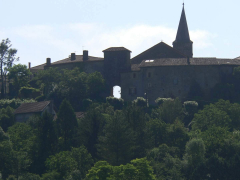 The events of the Chevauchee are recorded by court chroniclers Jean de Froisart, Le Baker, the Chandos Herald, various letters from Sir John Wingfield, an officer in the army and the Prince’s own notes as recorded in the Avesbury documents. The various documents are not consistent. There is considerable difference of opinion as to when the Prince left Bordeaux and which route he took on his journey east. There are records that he left Bordeaux as early as midsummers day, but also other records that he left as late as 5th October. There are similar discrepancies as to where he was in the intervening period, there are records of him being in Plympton, Plymouth, London, or alternatively Bordeaux itself. It would appear he managed to be in two places at once! The one thing on which there is general agreement is that he won a tournament in the grounds of the Palace of Woodstock sometime in March and that he was back in Bordeaux between the 9th and 12th of December.
The events of the Chevauchee are recorded by court chroniclers Jean de Froisart, Le Baker, the Chandos Herald, various letters from Sir John Wingfield, an officer in the army and the Prince’s own notes as recorded in the Avesbury documents. The various documents are not consistent. There is considerable difference of opinion as to when the Prince left Bordeaux and which route he took on his journey east. There are records that he left Bordeaux as early as midsummers day, but also other records that he left as late as 5th October. There are similar discrepancies as to where he was in the intervening period, there are records of him being in Plympton, Plymouth, London, or alternatively Bordeaux itself. It would appear he managed to be in two places at once! The one thing on which there is general agreement is that he won a tournament in the grounds of the Palace of Woodstock sometime in March and that he was back in Bordeaux between the 9th and 12th of December.
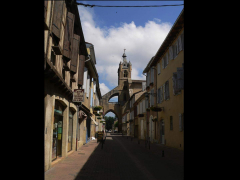 The is no better consistency in the record of the places he raided. The places named are Bazas, Castlenau, Arouille, Juliac, Moncler, Gabarret, Estang, Panjas, Galiax Mirande, Plaisance,Bassoues,Seissan, Simorre, Tournan, Samatan and St Lyse. Only Froissart mentions a crossing of the Garronne above Toulouse and yet local records at both Marmande and Agen record his visits. Not all of the above mentioned places occur in every record.
The is no better consistency in the record of the places he raided. The places named are Bazas, Castlenau, Arouille, Juliac, Moncler, Gabarret, Estang, Panjas, Galiax Mirande, Plaisance,Bassoues,Seissan, Simorre, Tournan, Samatan and St Lyse. Only Froissart mentions a crossing of the Garronne above Toulouse and yet local records at both Marmande and Agen record his visits. Not all of the above mentioned places occur in every record.
The Prince then by-passed Toulouse, where some records indicate a Frankish army had been assembled.
The Prince crossed the Garonne, heading for Carcassonne. His decision to leave a French army behind him has been described as “ contrary to military prudence” and “audacious to the point of foolhardy’’. Therefore either the Prince knew something the historians do not know or he had imperative reasons to travel further east.
The Garonne was crossed either at Lacroix-Falguarde or Portet, possibly both. The Chevauchee now raided, Montiscard, Baziege,Villfranche, Avignonet , Castlenaudry, Alzonne before reaching Carcassonne where they spent several days surveying “ La Cite” the citadel before decidind that it was not possible to take it by siege. The same process was followed at Narbonne again with a decision that the citadel was not vulnerable to siege. He sent scouts to evaluate the defences of Beziers and possibly Montpellier but then made a sudden decision to retrace his path.
Retreat
 At this point the records become not just fragmentory but contradictory. The majority of records indicate that the Prince passed to the north of Carcassonne visiting and resting at Pennautier, whereas the Le Baker record, based on field notes insists that on visits to Limoux, Fanjeaux and Lassere. These different reports are consistent with an army still moving on a broad front, covering the whole of the Val du Midi. Limoux and Lassere are different however.
At this point the records become not just fragmentory but contradictory. The majority of records indicate that the Prince passed to the north of Carcassonne visiting and resting at Pennautier, whereas the Le Baker record, based on field notes insists that on visits to Limoux, Fanjeaux and Lassere. These different reports are consistent with an army still moving on a broad front, covering the whole of the Val du Midi. Limoux and Lassere are different however.
Limoux is in a narrow valley running south from Carcassonne. Even today there is not a credible east-west route running through Limoux. It would have required a special visit, for what Purpose? The Le Baker record implies that the visit to Limoux was carried out by the rearguard under the command of the earl of Salisbury. The local records are certain that the Black Prince was involved in the raid which made a particular point of destroying the bishop’s palace.
The Territories of Foix
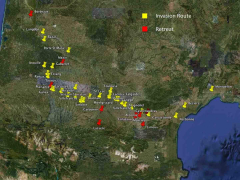 They then moved towards the Garronne continuing to attack certain selected unnamed targets but “ sparing territories belonging to the Compte de Foix” This is another surprise. it is by no means clear how they came anywhere near the territories of the Compte de Foix, which lay much further to the south. Lassere is similar again it is up a narrow valley leading to the south. Take the two together however and the may be some sense in it . There is a well established trade route originating on the Mediterranean Coast which passes through Couisa, Quillian, Foix ,St Girons, St Gaudens, Tarbres and Pau to the Atlantic Coast at either Bayonne or Bordeaux. This would have been a much safer return route for the Prince as much of the route was under English control. Meanwhile the main army could have occupied whatever opposition there may have been on the relatively flat lands in the centre of Armagnac. The Prince would have been unlikely to admit he removed himself from the front line but it is certainly a possibility which his personal bodyguard would have recommended. As the route lies directly through Foix it would also explain the comments about sparing the Compte’s territories.
They then moved towards the Garronne continuing to attack certain selected unnamed targets but “ sparing territories belonging to the Compte de Foix” This is another surprise. it is by no means clear how they came anywhere near the territories of the Compte de Foix, which lay much further to the south. Lassere is similar again it is up a narrow valley leading to the south. Take the two together however and the may be some sense in it . There is a well established trade route originating on the Mediterranean Coast which passes through Couisa, Quillian, Foix ,St Girons, St Gaudens, Tarbres and Pau to the Atlantic Coast at either Bayonne or Bordeaux. This would have been a much safer return route for the Prince as much of the route was under English control. Meanwhile the main army could have occupied whatever opposition there may have been on the relatively flat lands in the centre of Armagnac. The Prince would have been unlikely to admit he removed himself from the front line but it is certainly a possibility which his personal bodyguard would have recommended. As the route lies directly through Foix it would also explain the comments about sparing the Compte’s territories.
A great treasure
For the main army or perhaps only half the army, having crossed the Garonne, at Carbonne there was brief contact with a military force, but no conflict as the potential opposition promptly retreated. From that point onwards however there was an awarenessthat their retreat was being continually monitored.
One point on which all the records agree is that the Prince returned to Bordeaux with a baggage train “groaning under the weight of captured treasure” The assumption is that the miraculous recovery in Englands wealth had its foundation in this treasure. It is true that the famed “Crown Jewels’ had their origins at this time. But where did this treasure come from? The records claim that the majority of the treasure came from Carcassonne, Narbonne and Limoux and compete with each other to describe how large and wealthy these cities were. The records even complicate the issue by describing how large and wealth was the city of Toulouse.
It is also mentioned that in total over 500 villages and towns were pillaged and that this yeilded much booty. The suggestion is that this area had never known war and that gold silver and jewels were lying about on every kitchen table.
The mystery
 None of this rings true. The villages raided by the Prince were just that, villages. I have personally visited most of the named places and i am certain the sort of wealth described by the record did not come from there. Limoux was not a city and the Prince failed to take the citadels of Carcassone and Beziers where the real wealth, if there was any would have been stored. As has been noted he by-passed Toulouse , so its potential wealth is irrelevant.
None of this rings true. The villages raided by the Prince were just that, villages. I have personally visited most of the named places and i am certain the sort of wealth described by the record did not come from there. Limoux was not a city and the Prince failed to take the citadels of Carcassone and Beziers where the real wealth, if there was any would have been stored. As has been noted he by-passed Toulouse , so its potential wealth is irrelevant.
Further, excepting Armagnac, which had been protected by the English, these were the very lands which had been ravaged by the Albigensian crusade a hundred years earlier. In the latter stages of the crusade and the subsequent occupation by the Franks, crops were burned, wells poisoned, trees and vines uprooted and anything of value forcibly removed. Many of the villages and towns were “bastides” built as fortified towns and populated by norther franks. there was still open conflict between them and the natives of Occitan, perpetuated by the fact that they spoke a different language. This was not a land of wealth and privilege but a land of poverty and hardship.
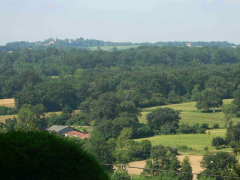 This raises the question of what the Prince was doing invading this territory, not one would think in pursuit of wealth. His original objective was “ to comfort our faithful friends”. This must be taken at face value. His objective was to unsettle the northern Franks in the territory they had unlawfully stolen and to give the native Occitans hope that deliverance was at hand. That leaves us with one of the great historical mysteries. Where did the treasure come, a treasure large enough to form the basis for the sustinance of the English nation? Was this the reason the Prince split the army in two and personally chose the southerly route?
This raises the question of what the Prince was doing invading this territory, not one would think in pursuit of wealth. His original objective was “ to comfort our faithful friends”. This must be taken at face value. His objective was to unsettle the northern Franks in the territory they had unlawfully stolen and to give the native Occitans hope that deliverance was at hand. That leaves us with one of the great historical mysteries. Where did the treasure come, a treasure large enough to form the basis for the sustinance of the English nation? Was this the reason the Prince split the army in two and personally chose the southerly route?
